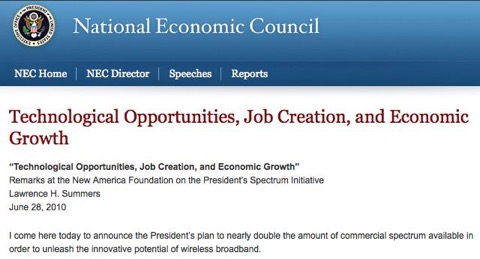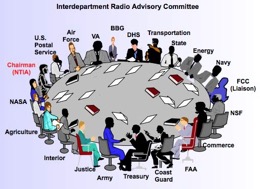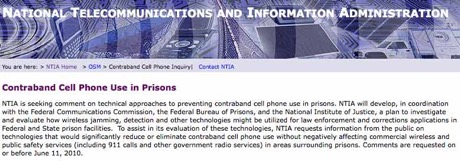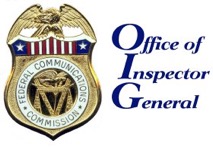White House Takes a More Active Spectrum Role

On 6/28/10 Lawrence H. Summers, Director of the White House's National Economic Council, spoke at the New America Foundation on the above topic and the President’s Spectrum Initiative - an odd recycling of a Bush 43 phrase that had no real impact.
Summers says the White House will push the necessary legislation to allow broadcasts to participate in “incentive auctions’ in which they could both profit and improve mobile service to the public, the vast majority of whom are not using spectrum for home connection to video.
NAB promptly replied,
"Expanding broadband is important, and broadcasters will work constructively with policymakers to help them attain that objective. We appreciate FCC assurances that further reclamation of broadcast television spectrum will be completely voluntary, and we're convinced that America can have both the finest broadband and broadcasting system in the world without jeopardizing the future of free and local TV service to tens of millions of viewers. We also believe the first priority of Congress ought to be passage of spectrum inventory legislation that identifies fallow spectrum or companies that may be 'warehousing' the airwaves."
Summers also said, “First, the government will examine how we are currently using spectrum and identify areas for improvement, consolidation, or sharing. To that end, we are pursuing a separate fast-track process to identify a down payment of specific bands of spectrum that could be freed up.”
In parallel with Summer’s talk, the White House released a Presidential Memorandum: Unleashing the Wireless Broadband Revolution. Here are some key sections:
(b) collaborate with the FCC to complete by October 1, 2010, a specific Plan and Timetable for identifying and making available 500 MHz of spectrum as described in subsection (a) of this section. For purposes of successfully implementing any repurposing of existing spectrum in accordance with subsection (a) of this section, the Plan and Timetable must take into account the need to ensure no loss of critical existing and planned Federal, State, local, and tribal government capabilities, the international implications, and the need for appropriate enforcement mechanisms and authorities;
(c) convene the Policy and Plans Steering Group (PPSG) to advise NTIA on achieving the objectives in subsections (a) and (b) of this section. The Secretaries of Defense, the Treasury, Transportation, State, the Interior, Agriculture, Energy, and Homeland Security, the Attorney General, the Administrators of the National Aeronautics and Space Administration (NASA) and the Federal Aviation Administration, the Director of National Intelligence, the Commandant of the United States Coast Guard, and the head of any other executive department or agency that is currently authorized to use spectrum shall participate and cooperate fully, or in the case of independent agencies are strongly encouraged to, in the activities of the Department of Commerce in accomplishing subsections (a) and (b) of this section and promptly provide appropriate funding and staff resources for agency support to these efforts and the work of the PPSG; and
(d) submit, not later than 180 days after the Plan and Timetable described in subsection (b) of this section are completed, to the National Economic Council (NEC), the Office of Management and Budget (OMB), and the Office of Science and Technology Policy (OSTP) an interim report to assess progress against the Plan and Timetable developed in accordance with subsection (b) of this section. Additional interim reports shall be submitted 180 days after the submission of the first interim report and then annually thereafter until such time as the Plan and Timetable are completed. In preparing these reports, the Secretary of Commerce shall work cooperatively with the FCC and other relevant departments, agencies, and offices.

I doubt if there will be any more meaningful sharing of federal spectrum unless the White House at least partially undoes the Nixon/Carter era reorganizations that moved the Section 305 power from the White House to the Commerce Department.
CTIA Locks Horns with San Francisco on Keeping the Public in the Dark on SAR Data

In a _______ (insert your own adjective. Suggested options: decisive, bold, stupid, vengeful, piquish, insane) act yesterday, CTIA-The Wireless Association challenged the City of San Francisco on whether continuing convention business from CTIA was more important than a certain action the elected representatives of the city recently took.
So what was this action that was so worthy of this strong and decisive retaliation from the cellular establishment?
• Were they putting a new tax on cell phones?
• Were they requiring recycling of cell phones?
• Were they regulating the ugliness of cell towers?
• Were they limiting the sale of anonymous prepaid cellphones to drug dealers and gang members?
No, even worse! Here is how the San Franscisco Examiner described SF’s horrific anti-cellular establishment deed:
The city's Board of Supervisors on Tuesday gave final approval to the country's first law requiring cell phone retailers to post the amount of radiation emitted by the phones they sell.
The board voted 10-1 to approve the first-of-its-kind ordinance that requires stores to disclose each phone's specific absorption rate, or SAR.
The measure is backed by Mayor Gavin Newsom, who is expected to sign it within 10 days.
"From our perspective, this is a very reasonable and quite modest measure that will provide greater transparency and information to consumers for whom this is an area of interest or concern," said Newsom spokesman Tony Winnicker, who noted that the mayor is an iPhone user. "We're playing a role that we've often played, which is to be at the forefront of a debate."
Here are the shocking actual words of the SF action:
San Francisco Cell-Phone Radiation Ordinance -

Then, yesterday CTIA retaliated with this announcement:
CTIA-The Wireless Association® Vice President of Public Affairs John Walls issued the following statement after the San Francisco Board of Supervisors approved the cell phone labeling ordinance (File No. 100104):
“CTIA and the wireless industry are disappointed that the San Francisco Board of Supervisors has approved the so-called 'Cell Phone Right-to-Know' ordinance. Rather than inform, the ordinance will potentially mislead consumers with point of sale requirements suggesting that some phones are 'safer' than others based on radiofrequency (RF) emissions. In fact, all phones sold legally in the U.S. must comply with the Federal Communications Commission's safety standards for RF emissions. According to the FCC, all such compliant phones are safe phones as measured by these standards. The scientific evidence does not support point of sale requirements that would suggest some compliant phones are 'safer' than other compliant phones based on RF emissions.
“While we have enjoyed bringing our three day fall show to San Francisco five times in the last seven years, which has meant we’ve brought more than 68,000 exhibitors and attendees and had an economic impact of almost $80 million to the Bay Area economy, the Board of Supervisors’ action has led us to decide to relocate our show. We are disappointed to announce that the 2010 CTIA Enterprise and Applications show in October will be the last one we have in San Francisco for the foreseeable future. We have already been contacted by several other cities that are eager to work with us and understand the tremendous benefits that wireless technology and our show can provide their area.” (CTIA does not explain that large conventions are booked several years in advance and changing the cities after booking incurs large penalties. So it appears that the non-SF venues for the next few conventions must have been decided previously.)
I was particularly fascinated by Mr. Walls’ sentence, “The scientific evidence does not support point of sale requirements that would suggest some compliant phones are 'safer' than other compliant phones based on RF emissions.” Could he please explain how scientific data could deal with “point of sale requirements”. Yes, there is no hard data that “some compliant phones are 'safer' than other compliant phones based on RF emissions.”. But there is no hard data that all cell phone exposure from handsets is safe either!
Readers might wish to review my 11/2/09 entry on this topic and the more responsible position taken by CTIA’s French counterpart, AFOM. I assume that the same physics applies in France as in CTIA’s homeland? AFOM suggests practical ways to reduce exposure such as using a Bluetooth earpiece or using your phones in area with better reception/more “bars”. Indeed, CTIA’s French counterpart even says on its website
For nonfrancophones, AFSSET is the French counterpart of EPA and OSHA and DAS is the term for SAR. Thus my unofficial translation of the header is AFSSET suggests picking a cellphone with low SAR. Shocking!!!
CTIA, does this mean you will add France to San Francisco on your list of boycotted locations for future meetings? Will CTIA staffers be able to attend any ITU or GSMA or ETSI meetings in France? Will CTIA member companies allow their staffers to travel to France on company business? Vacation?

Wired’s coverage of this news ends with these words, “Oddly, iPhone users in San Francisco may be safe, given how difficult it is to actually use the device as a phone in the city proper.”
Tekla Perry, a well known tech writer for IEEE Spectrum and a much better writer than your blogger, has written a blog piece on the SF decision describing how hard it is to get SAR information on cell phones at purchase time. Here is how she ends her essay:
The CTIA, the association that represents wireless manufacturers, is not happy about the San Francisco law, the first of its kind in the country. The CTIA says SAR information is irrelevant, and that no phones are safer than other phones. (I suppose CTIA members would rather compete on camera megapixels and apps and music capacity rather than radiation levels.) So it is going to make San Francisco pay—the CTIA is taking its annual trade show, held for the last seven years in San Francisco, elsewhere.
Wow. That’s like the cheese industry freaking out because they have to list fat grams on their labels.
But I can vote with my feet, too. The next time I buy a cell phone, I’ll be going to a retailer in San Francisco.
UPDATE
On 6/29/10 the Washington Post also wrote about CTIA’s actions. Some quotes:
The last major study done by the U.S. cellphone industry was published in 2002. Citing privacy concerns, corporations have declined to release records of heavy cellphone use to match against incidence of brain tumors.
The issue of children and cellphones has not been widely studied, even as three out of four teenagers use a cellphone. ...
Last month, 13 nations in Europe and Asia released the results of a decade-long study on long-term use. Scientists debated the results, saying the study was flawed because it relied too much on the subjects' memories of how much they used their phones.
The report, funded largely by the biggest global cellphone trade group, said that there was no conclusive link between cellphone use and cancer but that there were "suggestions" that heavy use could increase the risk of glioma. NIH issued a statement after the report's release, emphasizing that the study showed no link.
Comments on NTIA Prison Jamming NOI

Last Friday was the due date for comments on NTIA’s NOI on the use of jammers to deny inmates cellphone use in prisons. As discussed earlier, this NOI resulted from Congressional “guidance” in a report on budget legislation. No doubt this was a delaying tactic initiated by the cellular industry, but at least it helps “kick the ball down the road” since FCC has successfully ducked the issue to date. Indeed, while it is widely thought that FCC has ruled that Section 333 of the Comm Act prevents FCC from authorizing any jamming, the Commission has never made such a finding. No matter how many times NTIA and CTIA want to repeat this allegation, they have been unable to document it.
Yes, there are staff actions taken under delegated authority that in passing state that the Commission is restricted by Section 333. But these have never been ratified by the Commission or any case law. A filing last year by the South Carolina Department of Corrections gives an alternative explanation of the legislative history of Section 333 and options for authorizing cell phone jamming in prisons under present legislation. CTIA’s silence on the issue is deafening.
In the NTIA NOI CTIA started its comments dramatically:
Between May 17 and May 20, 2010, there was a significant interference event in downtown Philadelphia that disrupted commercial wireless service and GPS signals and involved the joint efforts of the Coast Guard, the FCC, the NCS, and carriers. Due to inference from a jammer, GPS equipment failed to work and navigation aids (including those used by the Coast Guard and potentially the FAA) and timing synchronization based on GPS at wireless base stations were disrupted. Numerous CMRS base station sites completely lost the ability to make voice and data communications work, resulting in excessive blocked and dropped calls, and wireless providers and first responders relying upon GPS for 911 calls‟ location information were adversely affected. This was due to a jammer.
Terrible! But what does this have to do with the use of jamming in isolated prisons under either pending legislation or the South Carolina petition that FCC has never even put out for public comment. This episode appears to be related to the FCC’s previously reported indifference to the marketing of GPS jammers where it took 23 months to close a case of marketing an obviously illegal device. Perhaps rather than using this as “evidence” that any prison jamming will be harmful, CTIA should press FCC why the FCC Enforcement Bureau was so dilatory in this GPS jammer case.
The CTIA comments repeat the usual allegations “that ‘overjamming’ is an inevitable outcome of the operation of jamming equipment in prisons”( p.20). They quote NTIA as follows:
The jammer emissions were transmitted entirely indoors. The targeted jamming zone was the interior of a two-floor reinforced cinderblock structure measuring 30 meters (m) long by 8 m wide. Jammer emissions were measured both indoors and outdoors, that is, both inside and outside the targeted jamming zone. . . . For the outdoor locations where jamming was not intended, the results showed that jammer power was measurable at distances up to 127 m from the building.
Was the “measurable” jammer power harmful interference? Was the 127m distance from the building an area accessible to the general public? Would anyone outside a maximum security prison with a large spatial buffer have been impacted by this jamming?
Finally, CTIA put great faith in “managed access”
Under managed access, when a call is made from a CMRS device located on prison grounds, the device recognizes the managed access system as the strongest signal, which enables the system to obtain information such as the device serial number, SIM card, or both. The managed access system would cross-reference this information against a database that indicates whether the device is unauthorized. If the system determines that the device is unauthorized, the managed access system does not permit the call to be completed and will either transmit a voice message to the caller, or direct the call to a designated official point of contact. Calls made from authorized devices will go through as intended.
Works like magic! Now, CTIA, here are some practical questions from the MSS comments to NTIA on the managed access alternative that you you have been dodging for a while:
- Who will pay for this managed access system you prefer?
- If it handles real legitimate revenue calls for the carrier should they pay at least part of the cost of the system?
- Are you advocating that FCC require all cellular carriers - not just the major carriers who control CTIA policy - to participate in managed access?
- Will CTIA support a regulation that forbids cellular carriers from implementing any technical change in their that will impact managed access until all the managed access systems are updated to cope with it? (Old timers will note that this would be similar to 1980s era Open Network Architecture/ONA of BOCs that they despised. This is ironic since the new AT&T is one of CTIA major members and is one of those BOCs of that era.)
CTIA repeatedly uses the word “overjamming” in its comments. A Google search shows no other use by anyone of such a phrase in anything resembling this context. However, it revealed a European music group called Overjam that has several YouTube videos. So in honor of CTIA’s recent contribution to spectrum jargon, here is a video from Overjam. Maybe CTIA can play it at the inevitable ex parte meetings on this topic on the 8th Floor:
Overjam Video
The cellular industry has made great contributions to public safety in many areas. But the epidemic of cell phone use in prisons and the horrendous consequences are an unintended consequence of ubiquitous small cell phones. Rather than respond with a FUD attack (fear, uncertainty, and doubt) on the jamming alternative, why doesn’t the cellular industry work more effectively with the corrections agencies to implement solutions that are both affordable and practical. Why doesn’t FCC get off the fence and pressure the cellular industry to make more progress in this area rather than focus on FUD.
UPDATE
Your blogger’s comments to NTIA have now been posted.
A Credible Inspector General Would Make FCC More Credible - Part 2

Thus today’s NY Times has an article about Justice IG Glenn Fine questioning the DOJ preparedness for WMD attacks. What, by contrast is the FCC IG investigating?
Well, the Universal Service Fund, Video Relay Service, and E-Rate programs involve billions of dollars and there is always going to be fraud there. And OIG has been busy pursuing these. (Although some of us wonder why OIG is the first line of defense here and shouldn’t there be another office checking on this persistent fraud closer to the policy side.)
On the internal side, the 4/09-9/09 IG Report finds “that after the Commission spent $3 million on Consumer Information Management System (‘CIMS’), the system did not work.and “ OIG concluded that mismanagement of the CIMS development project by contractor and Commission employees resulted in the failure of the CIMS project.” (p.37) It wasn’t clear what they thought should be learned from this of if any heads rolled.
We also learn that someone in Personnel took inappropriate action in hiring a relative. (p. 38). But those are the only internal issues. The previous IG report under the previous IG also only dealt with these internal issues.
Thus while DOJ’s Fine finds global issues to look into to improve DOJ, apparently FCC’s IG waits for the phone to ring. As I wrote previously, both IGs have the same legislative charter.
They are both obligated by 5 USC App. 4(a)(2)
Indeed, one could argue that the FCC IG has more independence from the FCC Chairman than the DOJ IG has from the Attorney General in that the DOJ IG has legislative restrictions on certain sensitive criminal and intelligence matters while the FCC IG has no such restrictions!to review existing and proposed legislation and regulations relating to programs and operations of such establishment and to make recommendations in the semiannual reports required by section 5 (a) concerning the impact of such legislation or regulations on the economy and efficiency in the administration of programs and operations administered or financed by such establishment...
So if the FCC is looking for something substantive to investigate to learn rom the past and improve future FCC operations, here are some topics to consider:
- How is the 800 MHz rebanding going and was it really a good idea?
- Indeed, how did the 800 MHz problem arise in the first place? Was it that unpredictable that the Nextel use might result in public safety interference? wasn’t it similar in some ways to the Channel 14 and 69 problems if the early 1980s, e.g. WVEU-TV Atlanta?
- How did it happen that lqrge numbers of wireless microphones were sold to noneligible parties creating a de facto reallocation of the UHF band and waht can be learned to prevent future de facto reallocations?
- How did it happen that no one remembered to kick all wireless microphones out of 700 MHz when they were auctioning the band for CMRS?
- Why did it take 10 years for VSAT complaints of interference from police band radar detectors to result in a new rule to prevent such emissions?
- Why did it take almost 2 years to act against a company selling GPS jammers?
- Indeed, is present enforcement of FCC equipment marketing rules credible?
- If someone marketed a new electronic device that caused massive interference to other spectrum users, how long realistically would it take FCC to respond based on precedents? (Consider both the case of marketing illegal devices, e.g. GPS jammer, or legal devices, e.g. radar detector.) One might think the large industry trade associations such as CTIA, APCO, NAB, and MSTV would be or should be interested in such a topic.
These points focus on spectrum issues, but I am sure that there are similar points in other aspects of Title II and Title III policy implementation.




![Validate my RSS feed [Valid RSS]](valid-rss-rogers.png)

